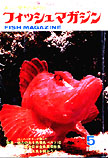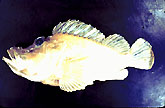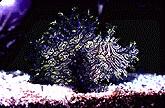

|
People, Places, and Things Research at the California Academy of Sciences |
William Eschmeyer, Ph.D., Senior Curator of Ichthyology
 This
wonderful specimen of red scorpionfish was kept in the Inoshima aquarium
in Japan. It appeared on the cover of a magazine because it periodically
shed "skin." It was not skin but more like a cuticular layer,
or a layer of hard mucous.
This
wonderful specimen of red scorpionfish was kept in the Inoshima aquarium
in Japan. It appeared on the cover of a magazine because it periodically
shed "skin." It was not skin but more like a cuticular layer,
or a layer of hard mucous.  This
occurs in other species of scorpionfishes and fishes and may be a way sedentary
fishes rid themselves of unwanted growth of such things as algae. The aquarium
sent the fish to me when it died, as I am a specialist in these kinds of
fishes. Even though it came to me without color (as color is lost on preservation),
upon examination I instinctively knew that it was a new species.
This
occurs in other species of scorpionfishes and fishes and may be a way sedentary
fishes rid themselves of unwanted growth of such things as algae. The aquarium
sent the fish to me when it died, as I am a specialist in these kinds of
fishes. Even though it came to me without color (as color is lost on preservation),
upon examination I instinctively knew that it was a new species.
Typically when we describe new animals we have at least several specimens
of the animal under investigation so we can rule out differences between
males and females, size-related differences, differences that may occur
geographically over the range of species, and to rule out atypical or abnormal
specimens. In this case I had only one specimen. I examined specimens of
the nearest relatives, counting and measuring fins and body parts and found
differences that showed that the Japanese specimen was a species never
before described. Therefore, two Japanese authors and I prepared a manuscript
describing and naming this species that was published in the Proceedings
of the California Academy of Sciences. This fish was very distinctive because
of its bright red coloration and the white streak below each eye in living
specimens. When we name new species, we follow a set of published "rules"
and the name is Latinized. In this case we selected the name argoliba which means white teardrop.
In this case we selected the name argoliba which means white teardrop.
This became about the 50,000th species of fish to be named and described in the scientific literature. (An even more spectacular relative, Rhinopias aphanes, from New Caledonia was described as new in the same publication). However, on average, each fish species actually has been named twice. Multiple names for one species are called synonyms and arise when two scientists each think they have a new species, but a third researcher discovers that the two are in fact one species. There are an estimated total of 25,000 valid species of fishes, and we are still finding more than 200 new species each year.
California Academy of Sciences Ichthyology Department
The Catalog of the Species of Fishes
Ichthyology Web Resources: Systematics
ICLARM: International Center for Living Aquatic Resources
Return to the People, Places, and Things Page.
Return to the Research Home Page of the California Academy of Sciences.
![]() California
Academy of Sciences, Golden Gate Park, San Francisco, California
California
Academy of Sciences, Golden Gate Park, San Francisco, California